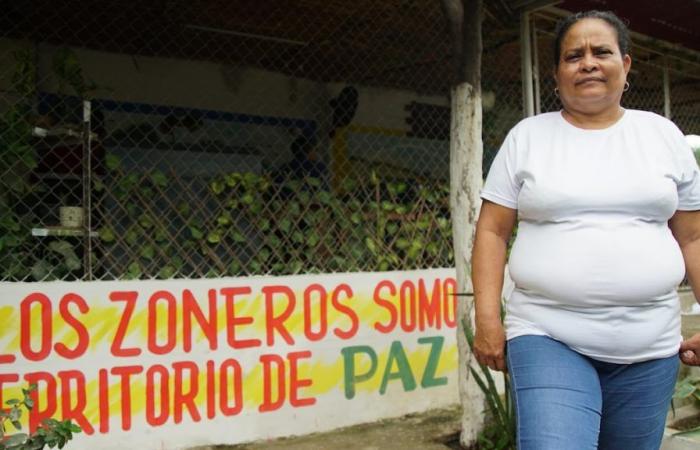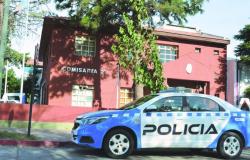
Among the single-story houses in the town of Orihueca, in the municipality of Zona Bananera (Magdalena), one stands out that is a few blocks from the train tracks. Its large terrace is full of tables, where dominoes are played or menus are served in which bananas and plantains are the protagonists, and its roofs have a layer of zinc and another of mat, that straw that is found on the banks. of the Ciénaga and with which the peasants used to make their mattresses to sleep in the mountains.
At the entrance, on a white wall that barely protrudes from the floor, a phrase is written in red and green letters that summarizes the battle that the soul of this home, Beatriz Helena García Lechuga, has undertaken: “We zoneros are territories of peace.”
The fingers of García’s left hand, leader of the Fundapaz Foundation’s El Chimborazo process, run along her right arm, caressing the scars from stab wounds and cuts that remind us of torture. Then, she rubs her hands; It’s as if she were lighting a fire, giving herself the impetus to tell everything that has happened to her.
García Lechuga says that when she reports that she lives in Orihueca, some respond by scratching their heads, looking to the side or saying: “Oh, but that’s hot there!” “We are not dangerous, the damage is done by those who are not from here. We want to show the country that in this municipality we are people of peace,” she emphasizes.
Zona Bananera, which has 14 townships and 46 villages, was established as a municipality in 1999. Before, it was part of Ciénaga, the epicenter of the banana business that brought with it the arrival of multinationals and violence that lasted for several decades.
In Orihueca, for example, the Seville Fruit Company first operated, a subsidiary of the United Fruit Company, responsible for the Banana Massacre of 1928, in which, according to historical records, more than a thousand people died.
In this house with a large terrace, zinc and mat roofs; In this house in which Beatriz Helena García Lechuga walks with her smile and her confident steps, those pages of horrors have been converted through art. The artist ‘La Magia’ captured a symbolic vision of the history of this municipality in three murals, which were supported by the Culture of Peace strategy of the Ministry of Cultures, Arts and Knowledge.
With that liquefied pronunciation, which occasionally crushes a letter, García Lechuga admires the murals and emphasizes their meaning: “We are going to tell from another point of view, from another field, everything that has happened here historically.”
Past
On her terrace, Beatriz constantly receives her compadres and comadres. At the end of this month, this space will be filled with more than one hundred families who have suffered alongside Beatriz’s in a story that began to be written in 2000. At that time, 112 families, who had their lands in the area of Chimborazo, in Pueblo Viejo, had organized and implemented a hybrid corn project with support from the Agrarian Bank. “Since those were virgin lands, imagine, it was a success!” recalls the leader.
This affection for the land is represented in the first mural, the one on the left, in which two oxen stand out, which were usually used as a means of transportation. The animals drag gondolas and around them a fertile land unfolds, irrigated by a crystalline stream. “Those animals were a means of work for us, they provided their strength and resistance to our work as farmers,” explains García Lechuga.
The tragedy for the 112 families began when “those gentlemen”—this is how Beatriz refers to the paramilitaries of the William Rivas front of the Northern Block of the AUC—arrived in the area and gave the inhabitants 24 hours to evacuate. García Lechuga was the first victim of that episode.
The paramilitaries also sexually abused 37 people from this community, including boys, girls, men and women. “Two years ago they operated on me, they had to cut part of my uterus… They did a lot of evil to us… It hurts me, but, well, let people know that the war for a piece of land has been very hard for us,” Beatriz emphasizes.
After the Banana Massacre in 1928, the banana business in Colombia has continued to leave a bloody trail. In fact, a Florida judge recently sentenced Chiquita Brands (formerly called United Fruit Company) to compensate victims of paramilitary groups in the subregions of Urabá Antioquia and Magdalena Medio. The company had already confessed to having financed the AUC between 1997 and 2004.
The William Rivas front, for example, was financed thanks to the contributions of banana companies and received weapons that arrived through the port that belonged to Chiquita in Urabá.
Beyond the violence, Orihueca has a deep relationship with literature, since they say that the Colombian Nobel Prize winner Gabriel García Márquez had an uncle and a cousin in the town, whom he used to visit. in his book Live to tellthe writer narrated that, on a train ride from Santa Marta, after passing through Río Frío, Orihueca and Guacamayal, he saw the sign of a farm that would inspire him to name the imaginary town of his crowning novel: Finca Macondo.
Macondo actually appears on the map beyond Orihueca, near Seville. It is a small train station with two farms from the time of the United Fruit Company.
One of Beatriz’s friends, the teacher and historian Juan Escobar Martínez, says that in 1928 in Orihueca there were already Jamaican-style houses built with materials brought from abroad. Escobar agrees with his comadre Beatriz that the inhabitants of this town are much more than that violence. “Here we are happy, we are tenacious. Our banana, which we have everywhere, is green, which is the color of hope and peace,” he adds.
Present
In the second mural, the one in the center, a naked woman with long black hair stands out. Hummingbirds and bluebirds surround her, as well as an extensive sky in which blue and white intermingle. “You see the environmental there, a woman resisting, a woman who can be Mother Earth. “Those are us women, the ones who fight and cry and long for the land,” says García Lechuga.
One of those women is her comadre Ligia Isabel Conrado Polo, who also belongs to the El Chimborazo process and who had to flee her land when the paramilitaries arrived. “We have been fighting for 24 years and there we are, firm. “Fearful, but there we are,” says Conrado, who says that during the flight from her land, which was at night, a branch hit her husband’s left eye, causing his retina to detach and, finally, he lost it.
Conrado Polo has been with García Lechuga in that fight for more than 20 years, during which they have exposed their case to different control entities, they have received support from institutions such as the Norwegian Refugee Council, the UN, the Victims Unit and now they are in the process with the Land Agency to recover those plots that the war took from them. “Some of our colleagues are already dying and nothing, they are still not giving us the land,” adds Ligia, who was born in Guacamayal.
Future
In the third mural, to the right of the terrace, a large ox is accompanied by rabbits, a dove, immense banana plants and the sticks that were used to stack corn and rice. “We want women and men to return to our territory as peasants and for this to be a symbol of peace,” says Beatriz.
In the Comprehensive Collective Reparation Plan that the community presented to the Victims Unit, and that they plan to implement once the lands are handed over to them, this group proposes a productive food transformation project that they have been preparing with the Sena and the University of the Magdalena. The raw materials would be popocho, banana and plantain.
Looking to the future, to that meeting at the end of the month, the leader says that a community potluck will be held for those more than one hundred guests. They are going to play dominoes and soccer, they are going to knit and they are going to tell stories. “People get tired of waiting. Imagine, we’ve been going since 2000 and nothing about the land, nothing about compensation. So, since things are already like hot cakes, we are going to resume again, to integrate,” she concludes.
Follow all the information from El PAÍS América in Facebook and xor in our weekly newsletter.





